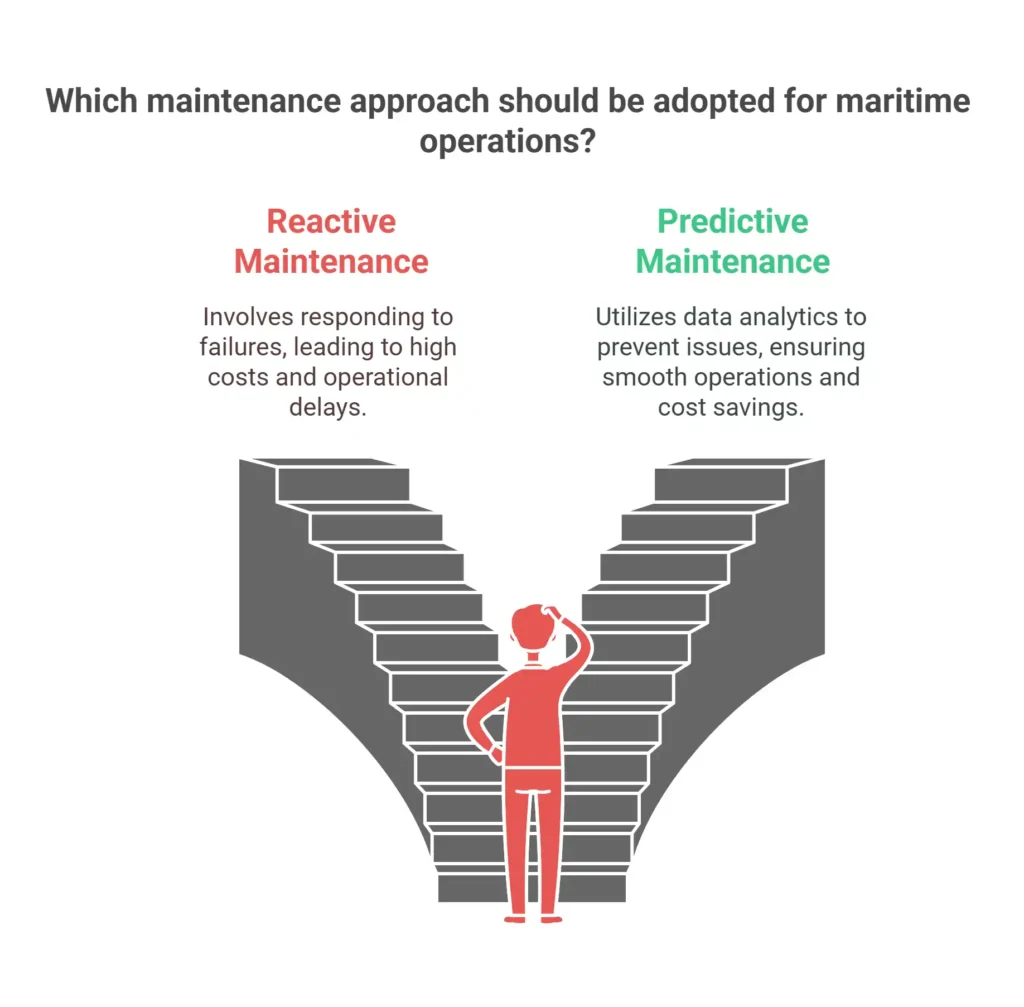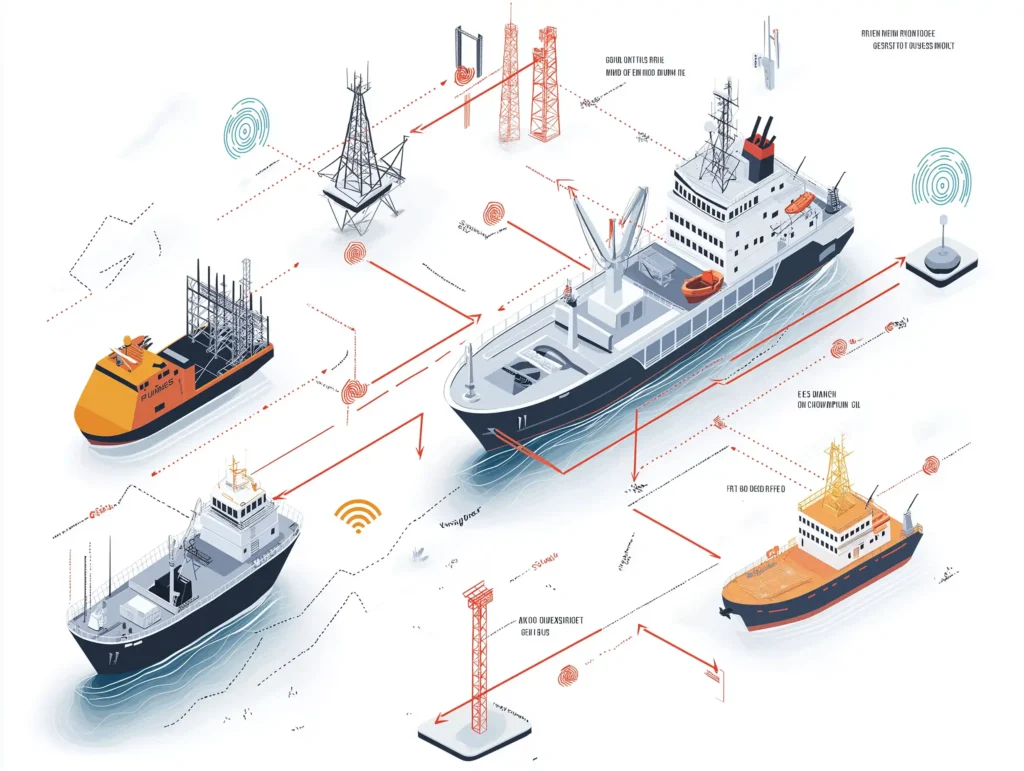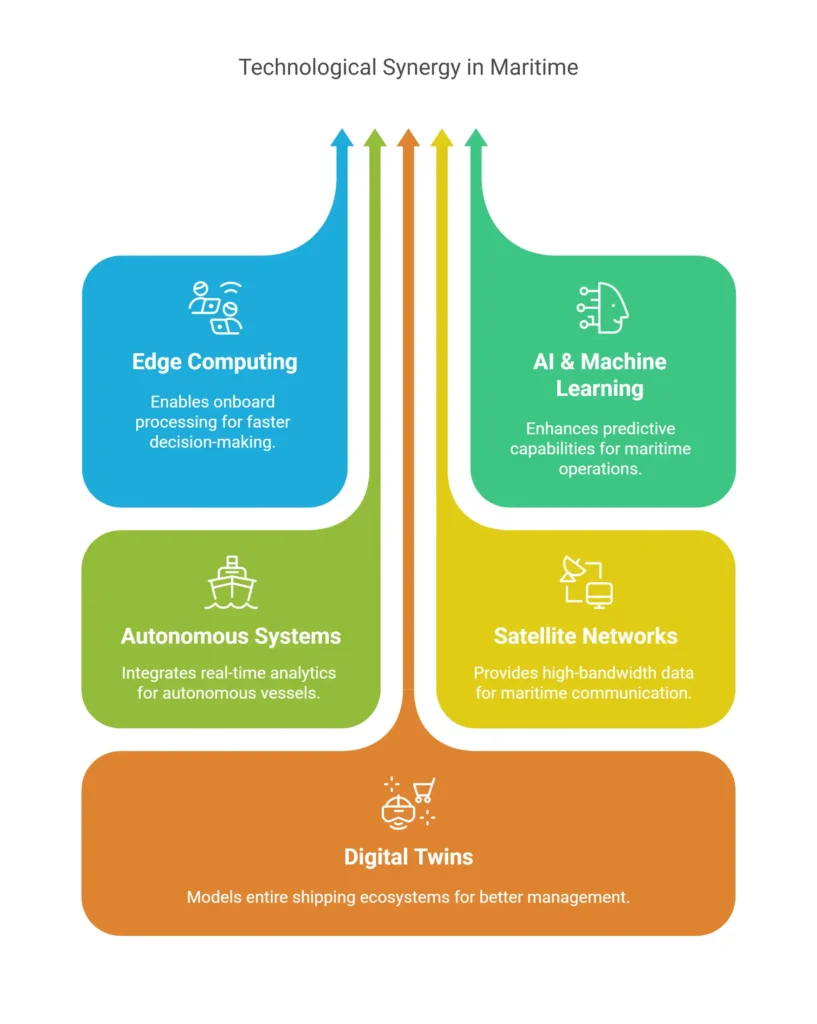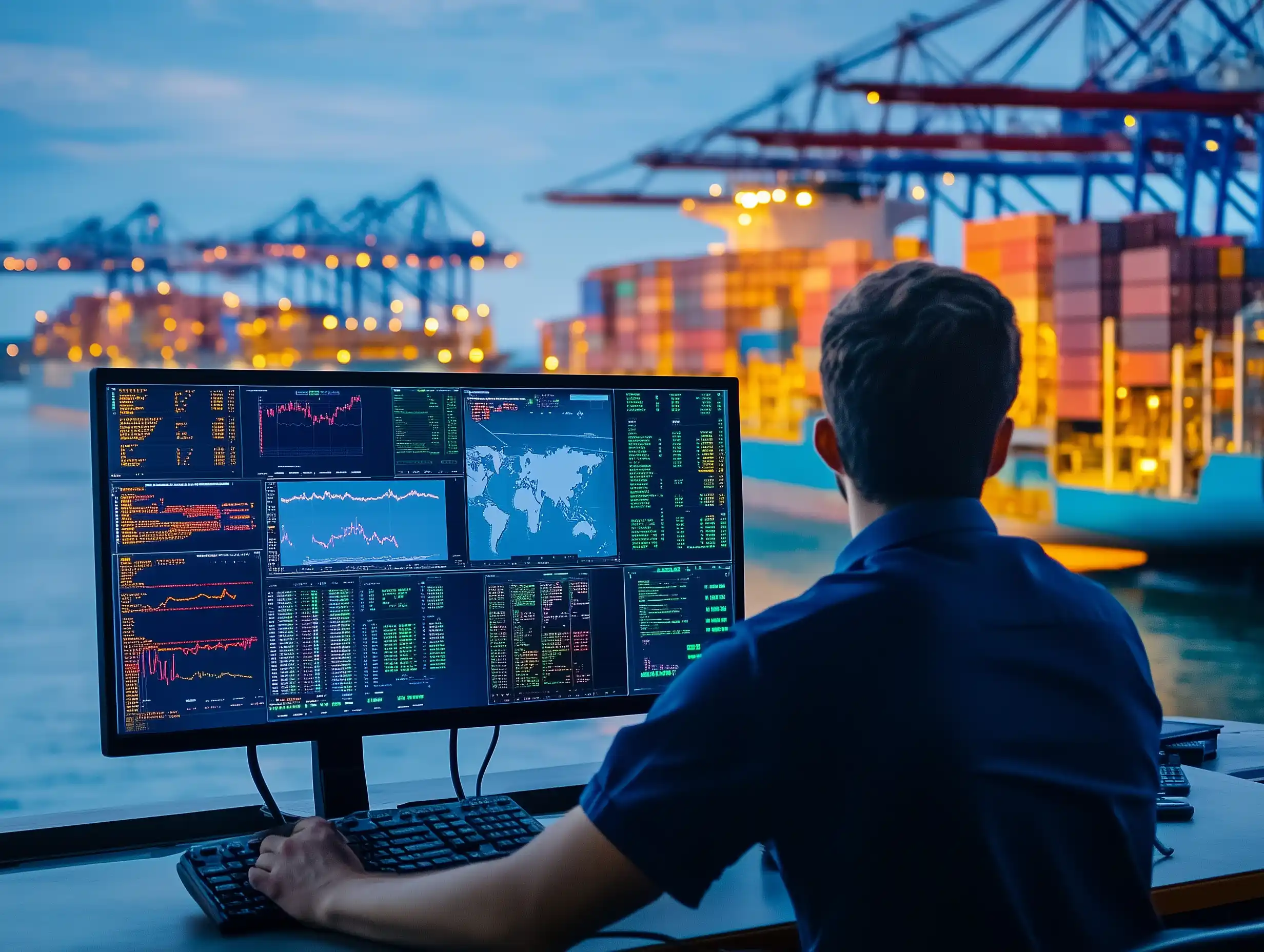Maritime operations now operate in a data-driven era where vessels and ports generate massive information streams, fueling significant advancements in efficiency, safety, and sustainability. Real-time big data analytics transforms these vast data flows into actionable insights, reducing fuel consumption by 12-18% and cutting maintenance costs by up to 55%.
Real Time Big Data Analytics: The Maritime Revolution
The global shipping industry moves over 90% of world trade, yet until recently operated with limited real-time decision-making capabilities. Today’s vessels continuously generate data through hundreds of sensors monitoring everything from engine performance to weather conditions. This wealth of information enables maritime companies to make immediate operational adjustments that dramatically improve efficiency.
Real-time big data analytics refers to the technology that collects, processes, and analyzes this massive volume of maritime data as it’s created, delivering instant insights that drive operational decisions. Unlike traditional analytics that examine historical patterns, real-time systems provide immediate awareness of current conditions, allowing for proactive rather than reactive management.
In examining the transformative potential of real-time big data analytics in the maritime industry, I’ve been particularly impressed by how it creates a paradigm shift from reactive to proactive operational management. The ability to process and analyze massive volumes of vessel data as it’s generated—rather than retrospectively—fundamentally changes how maritime companies navigate challenges and identify opportunities.
Through my work researching these systems, I’ve witnessed how continuous streams of sensor data from engine performance metrics, weather conditions, and port operations integrate to create actionable intelligence that drives decision-making. What’s most remarkable is the documented efficiency gains: fuel savings consistently reaching 12-18% and maintenance cost reductions of up to 55% represent not just significant economic benefits but substantial environmental improvements as vessels operate more efficiently.
This revolution extends beyond individual vessels to encompass the entire maritime ecosystem, creating a connected network of ships, ports, and logistics systems that share vital information. The resulting efficiency gains reduce costs while simultaneously lowering the environmental footprint of shipping operations.

Optimizing Vessel Routes Through Real-Time Intelligence
One of the most significant applications of real-time analytics involves continuous route optimization. Ships now adjust their courses dynamically based on current ocean conditions rather than following fixed paths. Advanced algorithms analyze multiple data streams including:
- Up-to-the-minute weather forecasts and sea conditions
- Real-time ocean current patterns and strengths
- Port congestion status and berth availability
- Traffic density in shipping lanes
- Fuel consumption rates at different speeds
When combined, these data sources enable systems to calculate the most efficient route moment by moment. A vessel might slightly alter course to capture favorable currents, adjust speed to arrive when port facilities become available, or reroute entirely to avoid developing storms.
The fuel savings from these optimizations consistently range between 12-18% across various vessel types. For a large container ship consuming 100 tons of fuel daily, this represents both substantial cost reduction and significant environmental benefits through lower emissions.
Vessel Performance Enhancement: Fine-Tuning Operations
Beyond route planning, real-time analytics provides continuous insights into vessel performance. Sensors throughout modern ships monitor countless parameters including:
- Engine efficiency and power output
- Hull resistance through water
- Optimal trim and ballast configurations
- Propeller efficiency and RPM
- Fuel quality and consumption rates
These systems detect subtle performance changes that human operators might miss. For example, minor hull fouling might increase drag by just 3%, but the resulting fuel penalty compounds over time. Real-time systems flag such inefficiencies immediately, allowing for prompt corrective action.
Performance optimization extends to everyday operational decisions as well. Crew members receive guidance on optimal speed settings based on current conditions, ideal engine loads for maximum efficiency, and even the most energy-efficient times to run onboard systems.
Predictive Maintenance: Preventing Problems Before They Occur
Perhaps the most revolutionary application of maritime analytics involves predicting equipment failures before they happen. Traditional maintenance followed either fixed schedules regardless of actual equipment condition or occurred reactively after breakdowns.
Real-time analytics enables condition-based predictive maintenance by:
- Continuously monitoring vibration patterns that indicate developing mechanical issues
- Tracking temperature anomalies across systems
- Analyzing fuel and lubricant quality and contamination
- Detecting minute changes in operating parameters that precede failures
- Comparing current readings against historical failure patterns
When the system detects warning signs, it alerts maintenance teams with specific information about the developing issue, recommended solutions, and parts needed. This approach reduces unplanned downtime by addressing problems during scheduled stops rather than experiencing failures at sea.

Industry data shows maintenance cost reductions averaging 55% after implementing these systems, with additional benefits from extended equipment lifespans, increased vessel availability, and enhanced safety. The shipping industry has particularly embraced this technology for critical propulsion systems and generators where failures can be extremely costly.
Read more:
- https://voyagex.ai/predictive-maintenance-fleet-downtime-costs/
- https://www.mdpi.com/2076-3417/14/20/9439
- https://splash247.com/the-death-of-scheduled-maintenance/
Port Management Transformation
The benefits of real-time analytics extend beyond vessels to revolutionize port operations. Modern ports function as information hubs, collecting and distributing data that optimizes the entire maritime supply chain. Real-time systems orchestrate:
- Dynamic berth allocation based on vessel arrivals and cargo types
- Just-in-time vessel arrivals that reduce waiting time and fuel consumption
- Efficient cargo handling equipment deployment
- Resource scheduling for labor, equipment, and facilities
- Traffic management within port areas
Major ports now deploy digital twin technology – virtual replicas of physical facilities that simulate operations in real time. These systems enable operators to test scenarios and optimize decisions before implementation, further enhancing efficiency.

The Port of Rotterdam exemplifies this approach, having implemented an extensive digital infrastructure that synchronizes vessel traffic, terminal operations, and hinterland connections. The resulting improvements include 20% faster vessel turnaround times and significant reductions in idle equipment.
Data Sources Powering Real Time Big Data Analytics at Sea
The effectiveness of real-time maritime analytics depends on the quality and diversity of data sources. Modern vessels and ports utilize numerous data collection systems:
- Automatic Identification System (AIS) transmits vessel position, speed, and heading
- Weather sensors provide local meteorological conditions
- Engine management systems monitor performance parameters
- Cargo tracking systems report load conditions and distribution
- Structural sensors detect stress and fatigue in vessel components
- Environmental sensors measure emissions and water quality
These systems generate terabytes of data daily across the global fleet. Advanced data transmission technologies ensure this information flows continuously between vessels, shore facilities, and centralized operations centers despite the challenges of maritime communications.

Satellite connectivity plays a crucial role, with modern VSAT (Very Small Aperture Terminal) systems providing the bandwidth necessary for real-time data exchange. Growing LEO (Low Earth Orbit) satellite networks promise even greater capacity and lower latency for maritime communications in coming years.
ROI of Real Time Big Data Analytics in Maritime Operations
The business case for real-time analytics in shipping operations remains compelling despite significant implementation costs. Most shipping companies report positive return on investment within 12-24 months of deployment.
Key ROI components include:
- Fuel savings from optimized routes and operations (12-18%)
- Maintenance cost reductions through predictive systems (up to 55%)
- Decreased port fees through optimal arrival timing
- Extended equipment lifespan from proper utilization
- Reduced insurance premiums from enhanced safety records
- Lower environmental compliance costs through emissions reductions
- Competitive advantage from improved service reliability
For a typical medium-sized shipping company with 15-20 vessels, these benefits can translate to millions in annual savings. Additionally, as environmental regulations tighten globally, the efficiency improvements delivered by real-time analytics become increasingly valuable for compliance purposes.
Data Sharing Hurdles in International Waters
While the technical capabilities of real-time maritime analytics continue advancing rapidly, significant obstacles remain around data sharing across international boundaries. Unlike other transportation sectors, maritime operations routinely cross multiple jurisdictions with varying regulations on data collection and transmission.
Nations with strategic interests in key shipping lanes often restrict certain data types for security reasons. China’s Maritime Traffic Safety Law requires foreign vessels in territorial waters to submit extensive data while limiting what those same vessels can collect. Similarly, Russia imposes data restrictions in Arctic passages and the Black Sea that complicate comprehensive analytics implementations.
These restrictions create “data shadows” where vessel operators must navigate with incomplete information, reducing efficiency and potentially increasing environmental risks. International maritime organizations continue working toward standardized data sharing protocols that balance legitimate security concerns with operational requirements.
The geopolitical dimensions of maritime data sharing highlight the importance of international cooperation in maximizing the benefits of real-time analytics. Transparent, reciprocal data sharing arrangements would enhance efficiency across global shipping networks while respecting legitimate sovereignty concerns.
Success Stories: Data-Driven Maritime Operations
Numerous shipping companies have successfully implemented comprehensive real-time analytics systems with impressive results. Major container shipping line Maersk deployed vessel optimization technology across its fleet, achieving consistent fuel savings of 12% while reducing emissions proportionally.
European ferry operator Stena Line implemented AI-powered route optimization and vessel management systems that delivered 15% fuel reductions while improving schedule reliability. The company’s predictive maintenance program reduced unplanned mechanical interventions by 50%, significantly enhancing service consistency.
Japanese shipping company NYK Line has extensively deployed real-time analytics for its LNG carrier fleet, where optimal operation is particularly critical. Their systems delivered maintenance cost reductions exceeding 40% while enhancing the safety profile of these specialized vessels.
These success stories demonstrate that real-time analytics benefits extend beyond cost savings to include enhanced safety, improved service quality, and reduced environmental impact – creating a compelling case for continued industry investment.
Future Directions for Real Time Big Data Analytics in Shipping
The evolution of maritime analytics continues accelerating, with several emerging technologies promising further capabilities:
- Edge computing will enable more processing directly onboard vessels
- AI and machine learning will enhance predictive capabilities
- Autonomous vessel systems will incorporate real-time analytics as core components
- Enhanced satellite networks will provide greater data bandwidth
- Maritime digital twins will expand to model entire shipping ecosystems

These advancements will further transform maritime operations, continuing the shift from reactive to proactive management approaches. The industry’s digital transformation has moved beyond early experimentation to become a fundamental aspect of competitive maritime operations.
As these systems mature, the industry will likely see additional consolidation around common data standards and increased collaboration between vessel operators, port authorities, and logistics providers – creating truly integrated maritime operations optimized through shared real-time intelligence.
FAQ
What is real-time big data analytics in maritime shipping?
Real-time big data analytics refers to technologies that collect and process massive amounts of operational data from vessels and ports as it’s generated, providing immediate insights that enable quick decision-making for improved efficiency, safety, and environmental performance.
How does big data reduce fuel consumption in shipping?
Big data reduces fuel consumption by continuously optimizing routes based on weather, currents, and traffic conditions; recommending optimal speeds and engine settings; ensuring vessels arrive at ports without waiting time; and detecting inefficiencies like hull fouling that increase fuel use.
What real-time data sources do modern vessels use?
Modern vessels use numerous data sources including engine management systems, weather sensors, AIS transponders, cargo monitoring systems, structural health sensors, fuel quality monitors, and satellite communications that transmit this information to shore-based analytics platforms.
How do predictive analytics prevent vessel breakdowns?
Predictive analytics prevent breakdowns by continuously monitoring equipment performance patterns, detecting subtle deviations from normal operation, identifying early warning signs of developing problems, and alerting maintenance teams before failures occur.
What is the ROI of real-time analytics in shipping?
The ROI for maritime analytics typically includes 12-18% fuel savings, up to 55% maintenance cost reductions, decreased port fees, extended equipment lifespan, reduced insurance premiums, lower environmental compliance costs, and competitive advantages from improved service reliability.


Leave a Reply